Influence of Structural Elements on the Spatial Sediment Displacement around a Jacket-Type Offshore Foundation
Abstract
1. Introduction
- To deepen the insights into the scour process around jacket structures and to reveal contributions of these processes to the temporal development of local and global scouring.
- To investigate the influence of vertical structural elements (i.e., structural distance of the lowest node to the seabed) on the time-dependent local scour development, local equilibrium scour depth and local spatial differences around the main piles.
- To propose improved prediction methods and discuss design recommendations for jacket-type offshore foundations.
- To analyze and quantify differences of displaced sediment volumes, incrementally and cumulatively, to investigate the influence of the distance of the lowest node to the seabed on erosion and deposition patterns around the foundation structure.
- To quantify the spatial volume change of displaced sediment per surface area, which exhibit an increased erosion or deposition of sediment, potentially affecting benthic flora and fauna.
2. Experimental Setup
Experimental Procedure and Test Conditions
- Smoothing the sand bed under wet conditions.
- Measuring of pre-scans and filling the wave basin.
- Running the desired wave spectrum with the smallest velocity, Uc, of the test series.
- Increasing the current velocity to the next larger velocity value and repeating Step 3.
- Increasing the current velocity to the highest velocity and repeating Step 3.
- Slowly emptying the wave basin and carefully draining the sand pit.
- Measuring of post-scans.
3. Results
3.1. Development and Final Scour Depth around the Main Piles
3.2. Bed Topography
3.3. Influence of the Structural Node Distance on Displaced Net Volume
3.4. Analysis of Deposition Patterns
4. Discussion
4.1. Remarks Regarding the Influence of Structural Elements on Scour Depth
4.2. Remarks Regarding Scale Effects
4.3. Remarks Regarding a Comparison between Echo Sounder and 3D Scan Data
5. Summary and Conclusions
- A comparison of final scour depths for 0D and 1D node distances reveals the influence of the structural elements, regarding a shorter distance of the lowest nodes and diagonal braces to the seabed on the local scour development. An improved empirical expression (Equation (6)) is proposed to flexibly account for the structural influence of closer nodes to the seabed, differentiating between 0D and 1D node distances. For piles located on the upstream side (Pile 1) a maximal difference of ΔSend/D = 0.15, was observed for a wave current velocity ratio of Ucw = 0.37 and a Keulegan–Carpenter number of KC = 14.9 for Test 4. For Pile 3, located on the downstream side of the structure (in view of the current direction), a maximal difference of ΔSend/D = 0.14 was observed for Ucw = 0.75 and KC = 6.7 of Test 3.
- Novel analyzing methods have been utilized to reveal spatial volume differences in complex sediment redistribution patterns, enabling a description and quantification of normalized erosion or deposition volumes, as well as a direct comparison between local scour depths and bathymetric data. A comparison of 3D scans with circular areas around each main pile illustrated an increased erosion of sediment for tests conducted in 0D node distance for Piles 1–4. Current-dominated conditions (Ucw = 0.75, Test 3) led to comparable erosion depth at the deepest point, combined with a flattened scour hole slope (for areas with a radial extent of 2.5–7D). Higher orbital and lower current velocities (Ucw = 0.56, Test 5) led to an increased erosion depth (from DI = 1.18, 1D to DI = 1.25, 0D), combined with a steeper scour hole slope, for areas of 2–5D.
- The present study reveals that even a small change of the lowest node’s distance from 0D to 1D can have a significant influence on the sediment mobility and displaced sediment volume around an OWF. This highlights the requirement to consider the interaction of the structure with the surrounding seabed within the design process of an OWF not only for reasons of sustainability and economy (reduced scour depth), but also to mitigate impacts on the former unaffected marine environment and benthic habitats due to an increased sediment mobility. The findings indicate that the lowered node and diagonal braces cause additional flow compression and near bed disturbance, which in turn induce a higher spatial erosion, especially in between the structure footprint area for current-dominated conditions, leading to a growth of the incremental volume depth ΔDI of up to 0.14 diameters (increase of 26%, Test 3), as well as a deeper and steeper local scour, but a less globally pronounced erosion for more wave-dominated hydrodynamic conditions, resulting in a growth of ΔDI of up to in 0.06 diameter (increase of 12%, Test 5).
- Despite an increased erosive potential underneath the structure, the present study also revealed an influence of the foundation structure on deposition patterns over a distance of more than 6.5 times the structure footprint length. Tests with a 0D node distance led to a 24% increased distance of the main share of deposited sediment (2.1A for 0D; 1.7A for 1D) for current-dominated conditions (Test 3), with a spatial offset in current direction but a comparable cumulative deposition volume. However, more wave-dominated conditions (Test 5) led to an increased distance of the deposition pattern of 50% for a 0D node distance (1.5A, 0D and 1A, 1D) combined with an increased cumulative deposition volume.
Author Contributions
Funding
Acknowledgments
Conflicts of Interest
Nomenclature
| A | Reference distance times the structure footprint length; |
| A = x or y distance/structure footprint distance, e.g., 0.5 A = 0.25 m/0.55 m | |
| ai | Interrogation area ai in dependence to i |
| Ag | Area related to one datapoint, depending on the grid resolution of the 3D scan |
| D | Pile Diameter of the main struts of the jacket structure |
| DA,i | Cumulative volume depth; relative volume change per surface area of an individual volume |
| Vi of an area ai in reference to the pile diameter D | |
| DI,i | Incremental volume depth; relative volume change per surface area of an individual volume |
| Vi − Vi−1 within adjacent areas ai − ai−1 in reference to the pile diameter D | |
| Cumulative integral of DI,i subtracted by the uninfluenced ripple deposition value | |
| d50 | Grain size for which 50% of the material by weight is finer |
| f | Frequency |
| Hs | Significant wave height |
| KC | Keulegan–Carpenter number; KC = (Um × Tp)/D |
| S | Scour depth |
| S(f) | Velocity frequency spectrum |
| Send | Mean value of the last 25% of the measured scour depth signal |
| Tp | Peak wave period |
| U | Orbital velocity at the bed in direction of the waves |
| Uc | Undisturbed current velocity at 2.5D from bed |
| U | Mean current velocity of the vertical profile |
| Ucw | Wave–current velocity ratio Ucw = Uc/Uc + Um |
| Um | Undisturbed maximum orbital velocity at 2.5D from bed |
| Urms | Root-mean-square (RMS) value of U at the seabed |
| Verosion | Eroded sediment volume in m3 below the pre-scan of each test |
| Vdepositions | Deposited sediment volume in m3 above the pre-scan of each test |
| Vi | Displaced sediment volume in m3 |
| Z | Elevation difference between the pre- and post-scan, calculated for each interpolated grid point |
| Shields parameter |
References
- Brodny, J.; Tutak, M. Analyzing similarities between the European Union countries in terms of the structure and volume of energy production from renewable energy sources. Energies 2020, 13, 913. [Google Scholar] [CrossRef]
- IRENA. Renewable Energy Statistics 2018; The International Renewable Energy Agency: Abu Dhabi, UAE, 2018. [Google Scholar]
- GWEC. Global Wind Report 2018; Global Wind Energy Council: Brussels, Belgium, 2018. [Google Scholar]
- WindEurope. Offshore Wind in Europe: Key Trends and Statistics 2018; WindEurope: Brussels, Belgium, 2019. [Google Scholar]
- Elliott, M. The role of the DPSIR approach and conceptual models in marine environmental management: An example for offshore wind power. Mar. Pollut. Bull. 2002, 6, iii–vii. [Google Scholar] [CrossRef]
- Wilson, J.; Elliott, M. The Habitat-creation Potential of Offshore Wind Farms. J. Prog. Appl. Wind Power Convers. Technol. 2009, 12, 203–212. [Google Scholar] [CrossRef]
- Miller, R.G.; Hutchison, Z.L.; Macleod, A.K.; Burrows, M.T.; Cook, E.J.; Last, K.S.; Wilson, B. Marine renewable energy development: Assessing the Benthic Footprint at multiple scales. Front. Ecol. Environ. 2013, 11, 433–440. [Google Scholar] [CrossRef]
- Vanhellemont, Q.; Ruddick, K. Turbid wakes associated with offshore wind turbines observed with Landsat 8. Remote Sens. Environ. 2014, 145, 105–115. [Google Scholar] [CrossRef]
- Grashorn, S.; Stanev, E.V. Kármán vortex and turbulent wake generation by wind park piles. Ocean Dyn. 2016, 66, 1543–1557. [Google Scholar] [CrossRef]
- Shields, M.A.; Woolf, D.K.; Grist, E.P.M.; Kerr, S.A.; Jackson, A.C.; Harris, R.E.; Bell, M.C.; Beharie, R.; Want, A.; Osalusi, E. Marine renewable energy: The ecological implications of altering the hydrodynamics of the marine environment. Ocean Coast. Manag. 2011, 54, 2–9. [Google Scholar] [CrossRef]
- Carpenter, J.R.; Merckelbach, L.; Callies, U.; Clark, S.; Gaslikova, L.; Baschek, B. Potential Impacts of Offshore Wind Farms on North Sea Stratification. PLoS ONE 2016, 11, e0160830. [Google Scholar] [CrossRef]
- Heery, E.C.; Bishop, M.J.; Critchley, L.P.; Bugnot, A.B.; Airoldi, L.; Mayer-Pinto, M.; Sheehan, E.V.; Coleman, R.A.; Loke, L.H.; Johnston, E.L.; et al. Identifying the consequences of ocean sprawl for sedimentary habitats. J. Exp. Mar. Biol. Ecol. 2017, 492, 31–48. [Google Scholar] [CrossRef]
- Hjorth, P. Studies on the Nature of Local Scour. Inst. för Teknisk Vattenresurslära; University of Lund: Lund, Sweden, 1975. [Google Scholar]
- Melville, B.W.; Sutherland, A.J. Design method for local scour at bridge piers. J. Hydraul. Eng. 1988, 114, 1210–1226. [Google Scholar] [CrossRef]
- Melville, B.W.; Coleman, S.E. Bridge Scour; Water Resources Publications, LLC.: Lone Tree, CO, USA, 2000. [Google Scholar]
- Sheppard, D.M.; Miller, W. Live-bed local pier scour experiments. J. Hydraul. Eng. 2006, 132, 635–642. [Google Scholar] [CrossRef]
- Breusers, H.N.C.; Nicollet, G.; Shen, H.W. Local scour around cylindrical piers. J. Hydraul. Res. 1977, 3, 211–252. [Google Scholar] [CrossRef]
- Sumer, B.M.; Fredsøe, J.; Christiansen, N. Scour around a vertical pile in waves. J. Waterw. Port Coast. Ocean Eng. 1992, 118, 15–31. [Google Scholar] [CrossRef]
- Sumer, B.M.; Arnskov, M.M.; Christiansen, N.; Jørgensen, F.E. Two-component hot-film probe for measurements of wall shear stress. J. Exp. Fluids 1993, 15, 380–384. [Google Scholar] [CrossRef]
- Sumer, B.M.; Christiansen, N.; Fredsøe, J. The horseshoe vortex and vortex shedding around a vertical wall-mounted cylinder exposed to waves. J. Fluid Mech. 1997, 332, 41–70. [Google Scholar] [CrossRef]
- Kobayashi, T.; Oda, K. Experimental study on developing process of local scour around a vertical cylinder. Coast. Eng. 1994, 2, 1284–1297. [Google Scholar] [CrossRef]
- Sumer, B.M.; Fredsøe, J. Scour around pile in combined waves and current. J. Hydraul. Eng. 2001, 127, 403–411. [Google Scholar] [CrossRef]
- Rudolph, D.; Bos, K.J.; Luijendijk, A.P.; Rietema, K.; Out, J.M.M. Scour around Offshore structures—Analysis of Field Measurements. In Proceedings of the Second International Conference on Scour and Erosion, ICSE 2, Singapore, 14–17 November 2004. [Google Scholar]
- Welzel, M.; Schendel, A.; Hildebrandt, A.; Schlurmann, T. Scour development around a jacket structure in combined waves and current conditions compared to monopile foundations. Coast. Eng. 2019, 152, 103515. [Google Scholar] [CrossRef]
- Porter, K.E. Seabed Scour Around Marine Structures in Mixed and Layered Sediments. Ph.D. Thesis, University College London (UCL), London, UK, 2016. [Google Scholar]
- Umeda, S.; Yamazaki, T.; Ishida, H. Time evolution of scour and deposition around a cylindrical pier in steady flow. In Proceedings of the International Conference on Scour and Erosion, Tokyo, Japan, 5–7 November 2008; pp. 140–146. [Google Scholar]
- Bouratsis, P.; Diplas, P.; Dancey, C.L.; Apsilidis, N. Quantitative Spatio-Temporal Characterization of Scour at the Base of a Cylinder. Water 2017, 9, 227. [Google Scholar] [CrossRef]
- Margheritini, L.; Frigaard, P.; Martinelli, L.; Lamberti, A. Scour around monopile foundations for offshore wind turbines. In Proceedings of the First International Conference on the Application of Physical Modelling to Port and Coastal Protection (CoastLab06), Porto, Portugal, 8–10 May 2006; Faculty of Engineering, University of Porto: Porto, Portugal, 2006. [Google Scholar]
- Hartvig, P.A.; Thomsen, J.M.; Frigaard, P.; Andersen, T.L. Experimental Study of the development of scour and backfilling. Coast. Eng. J. 2010, 52, 157–194. [Google Scholar] [CrossRef]
- Stahlmann, A.; Schlurmann, T. Kolkbildung an komplexen Gründungsstrukturen für Offshore-Windenergieanlagen—Untersuchungen zu Tripod-Gründungen in der Nordsee. Bautechnik 2012, 89, 293–300. [Google Scholar] [CrossRef]
- Link, O.; Pfleger, F.; Zanke, U. Characteristics of developing scour-holes at a sand-embedded cylinder. Int. J. Sediment Res. 2008, 23, 258–266. [Google Scholar] [CrossRef]
- Schendel, A.; Goseberg, N.; Schlurmann, T. Experimental Study on the Erosion Stability of Coarse Grain Materials under Waves. J. Mar. Sci. Technol. 2015, 23, 937–942. [Google Scholar] [CrossRef]
- Fazeres-Ferradosa, T.; Welzel, M.; Schendel, A.; Baelus, L.; Santos, P.R.; Pinto, F.T. Extended characterization of damage in rubble mound scour protections. Coast. Eng. 2020, 103671. [Google Scholar] [CrossRef]
- Welzel, M.; Schendel, A.; Schlurmann, T.; Hildebrandt, A. Volume-based assessment of erosion patterns around a hydrodynamic transparent offshore structure. Energies 2019, 12, 3089. [Google Scholar] [CrossRef]
- Welzel, M.; Schlurmann, T.; Hildebrandt, A. Local scour development and global sediment redistribution around a jacket-structure in combined waves and current. In Proceedings of the Ninth International Conference on Scour and Erosion, ICSE 9, Taipei, Taiwan, 5–8 November 2018. [Google Scholar]
- Schendel, A. Wave-Current-Induced Scouring Processes and Protection by Widely Graded Material, Dissertation; Gottfried Wilhelm Leibniz Universität: Hannover, Germany, 2018. [Google Scholar] [CrossRef]
- Chen, H.H.; Yang, R.Y.; Hwung, H.H. Study of hard and soft countermeasures for protection of the jacket-type offshore wind turbine foundation. J. Mar. Sci. Eng. 2014, 2, 551–567. [Google Scholar] [CrossRef]
- Ettema, R.; Melville, B.W.; Barkdoll, B. Scale effects in pier-scour experiments. J. Hydraul. Eng. 1998, 124, 639–642. [Google Scholar] [CrossRef]
- Tanaka, H.; Dang, V.T. Geometry of sand ripples due to combined wave-current flows. J. Waterw. Port Coast. Ocean Eng. 1996, 122, 298–3000. [Google Scholar] [CrossRef]
- Van Rijn, L.C.; Havinga, F.J. Transport of fine sands by currents and waves II. J. Waterw. Port Coast. Ocean Eng. 1995, 121, 123–133. [Google Scholar] [CrossRef]
- Sutherland, J.; Whitehouse, R.J.S. Scale Effects in the Physical Modelling of Seabed Scour; Report TR 64; HR Wallingford: Wallingford, UK, 1998. [Google Scholar]
- Crameri, F.; Shephard, G.E. Scientific colour maps. Zendo 2018. [Google Scholar] [CrossRef]
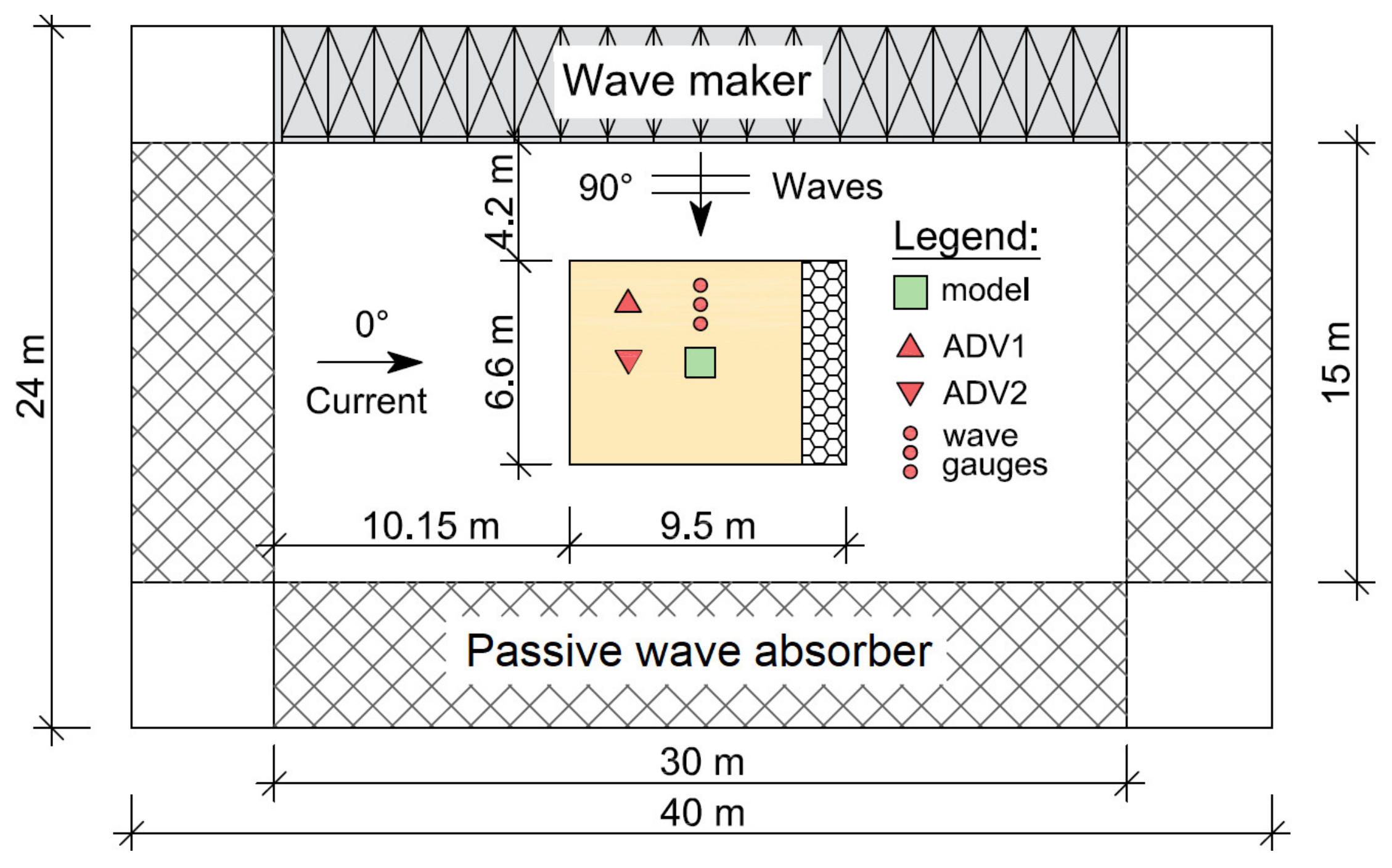
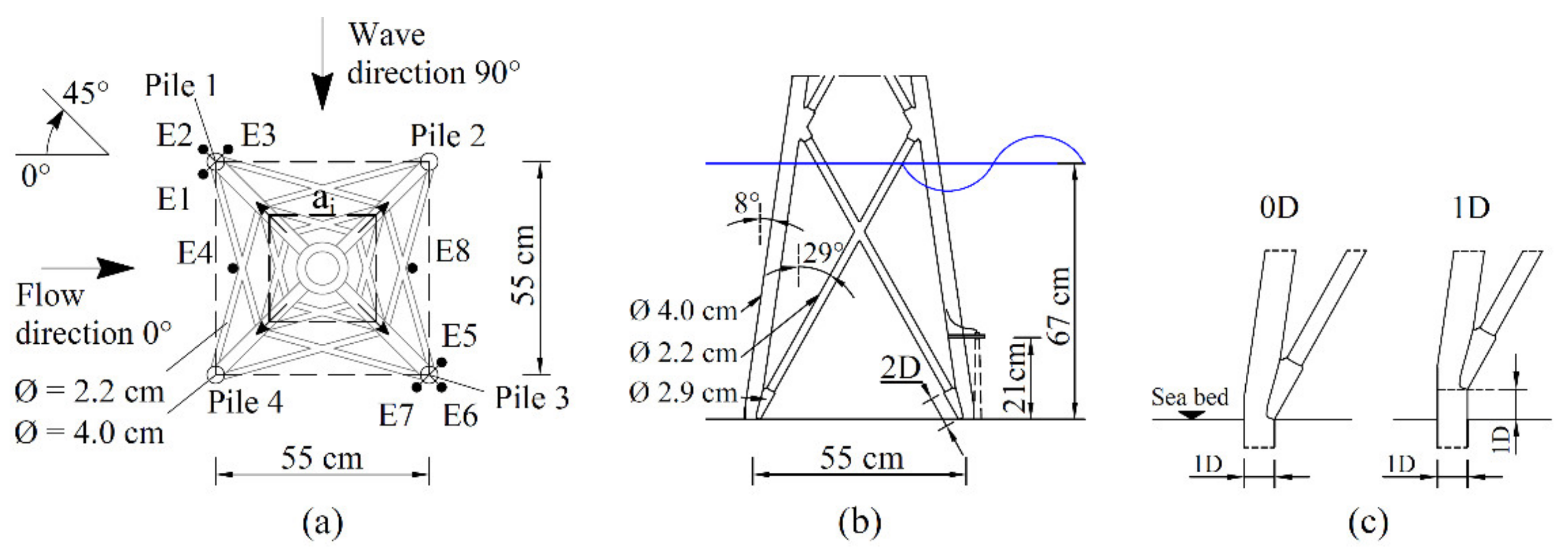
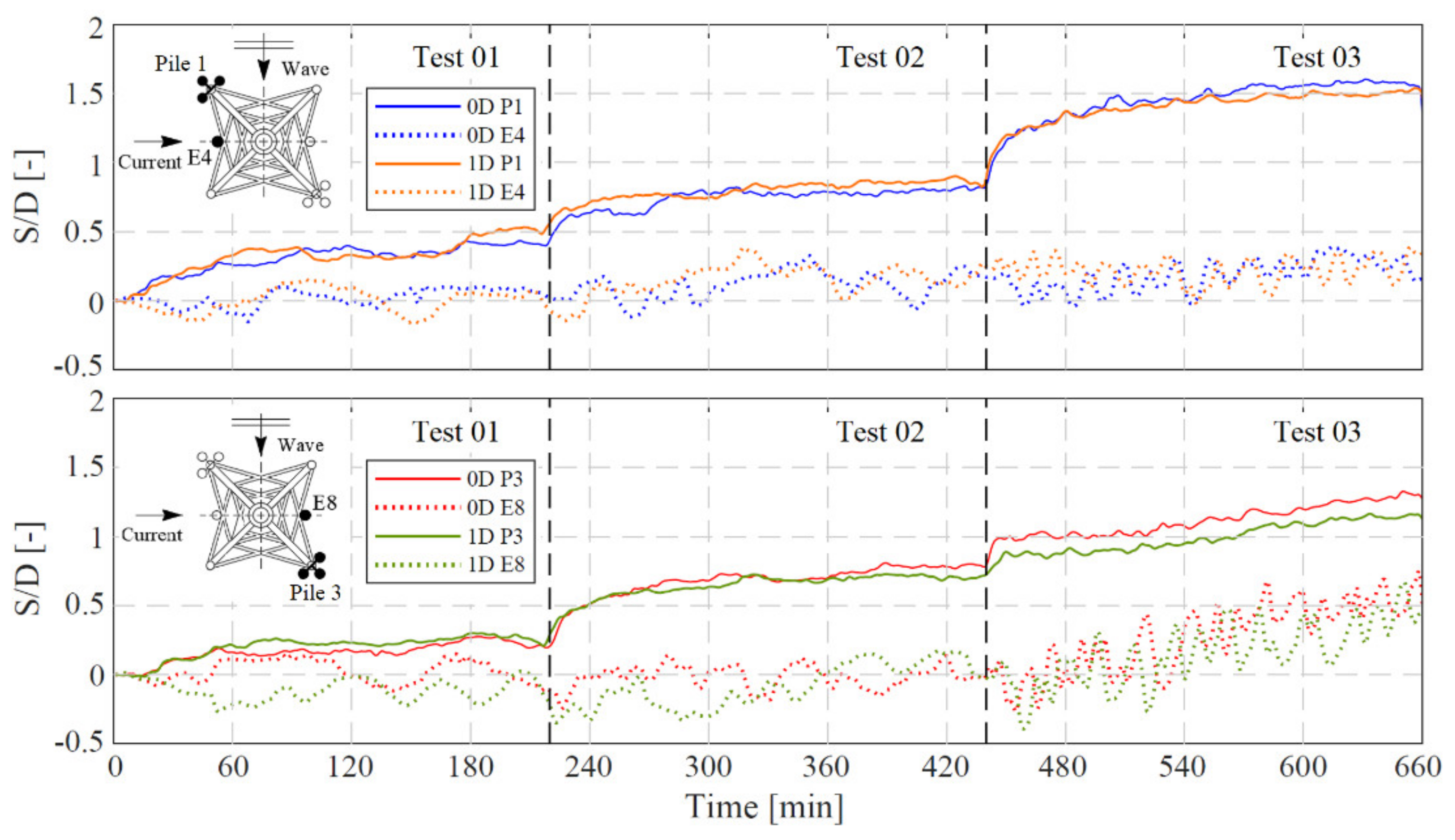
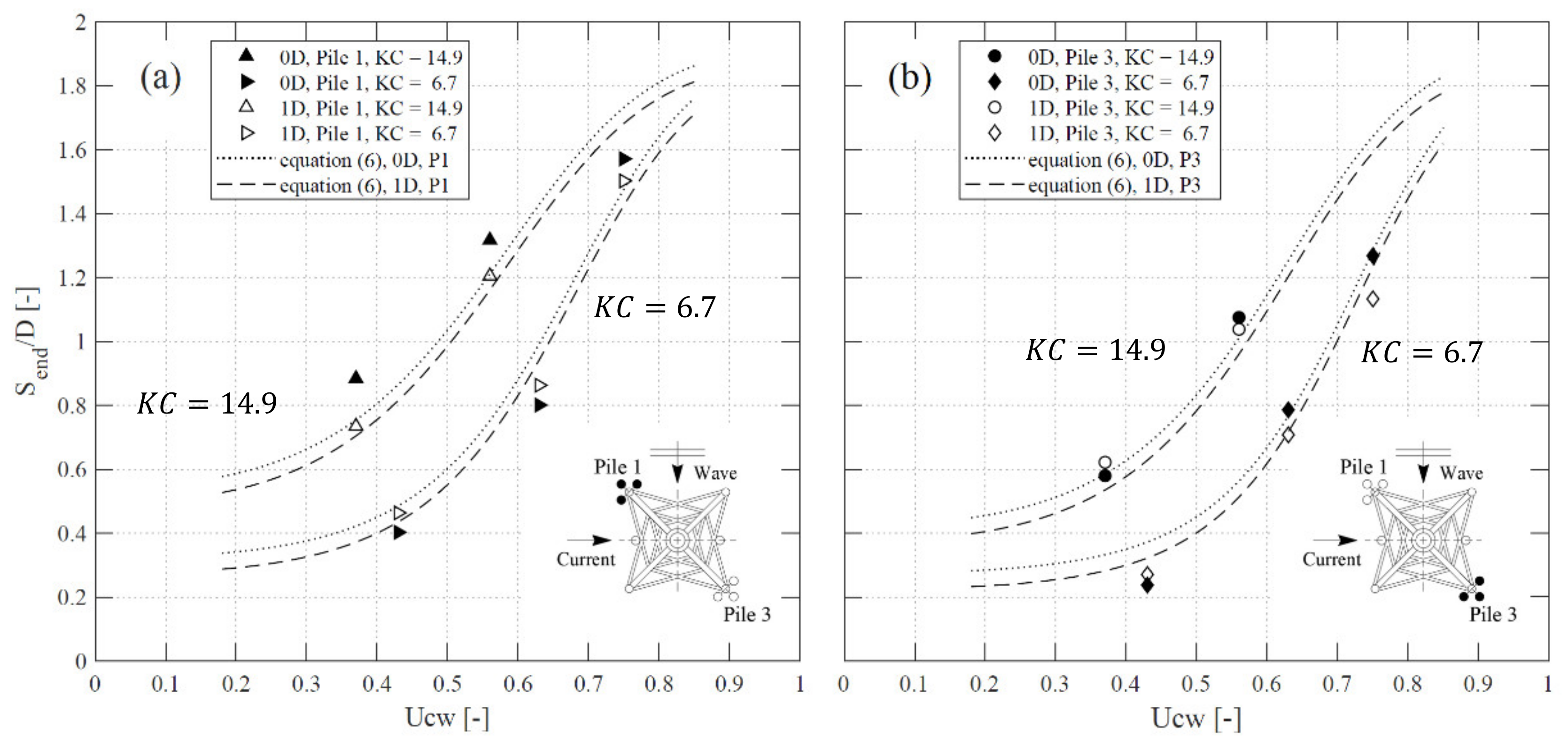
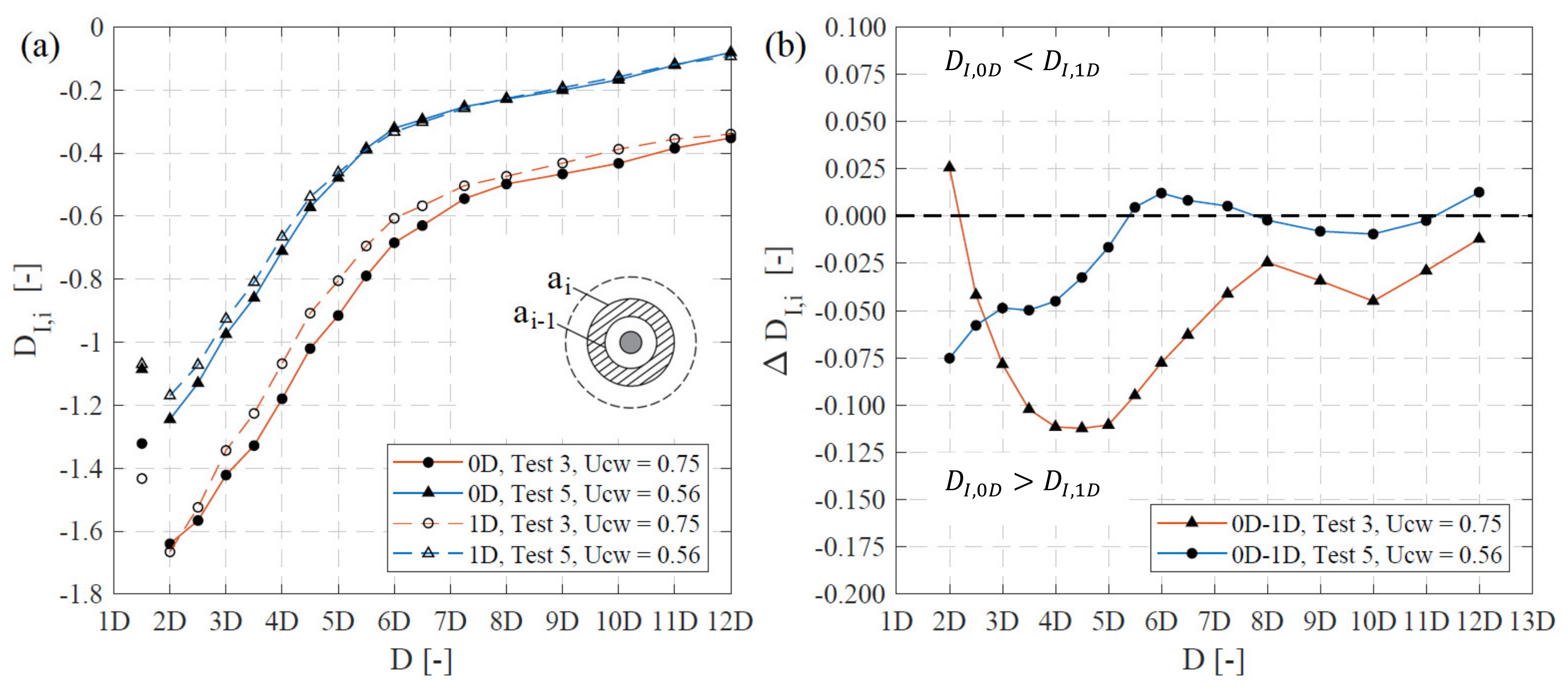
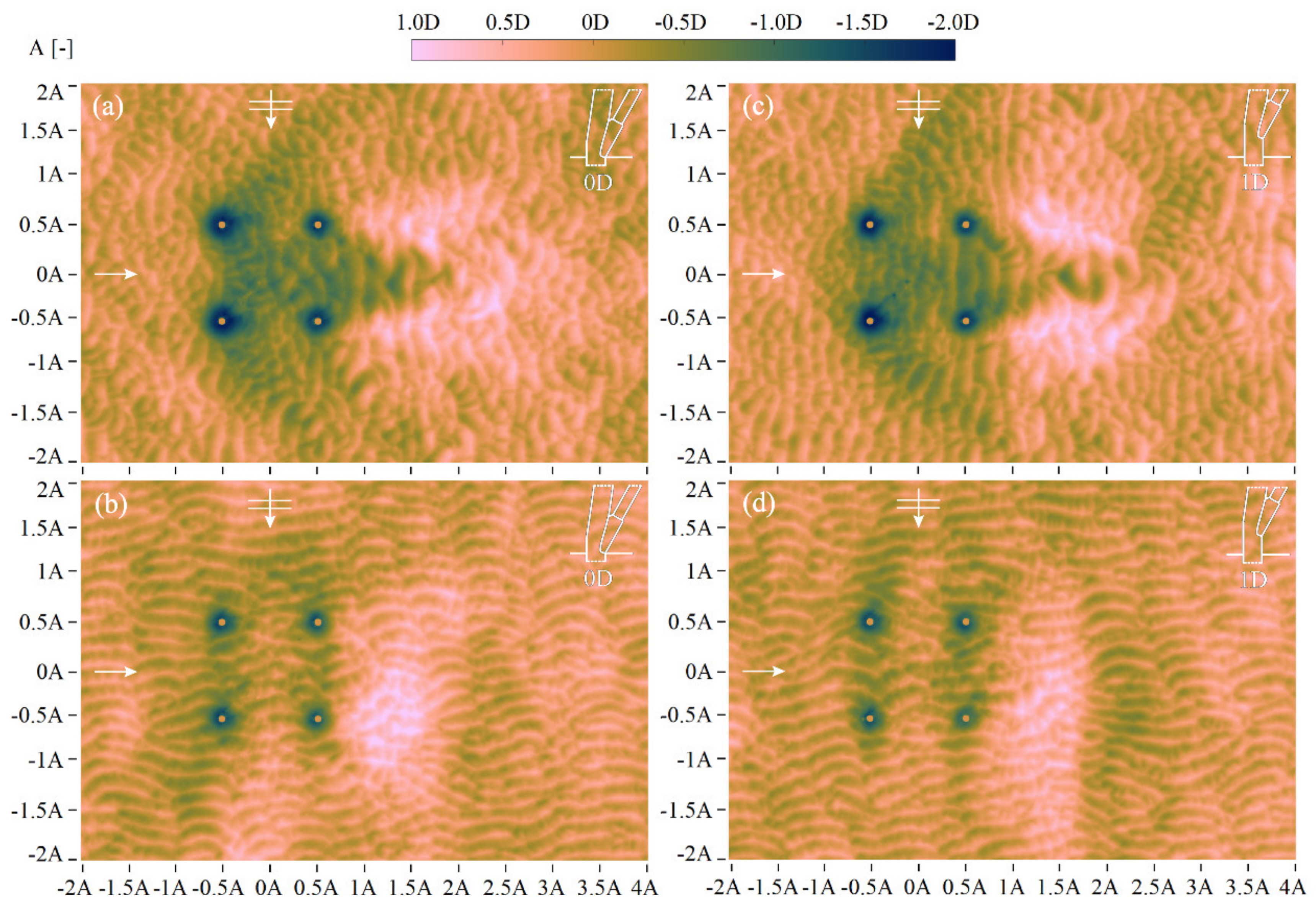
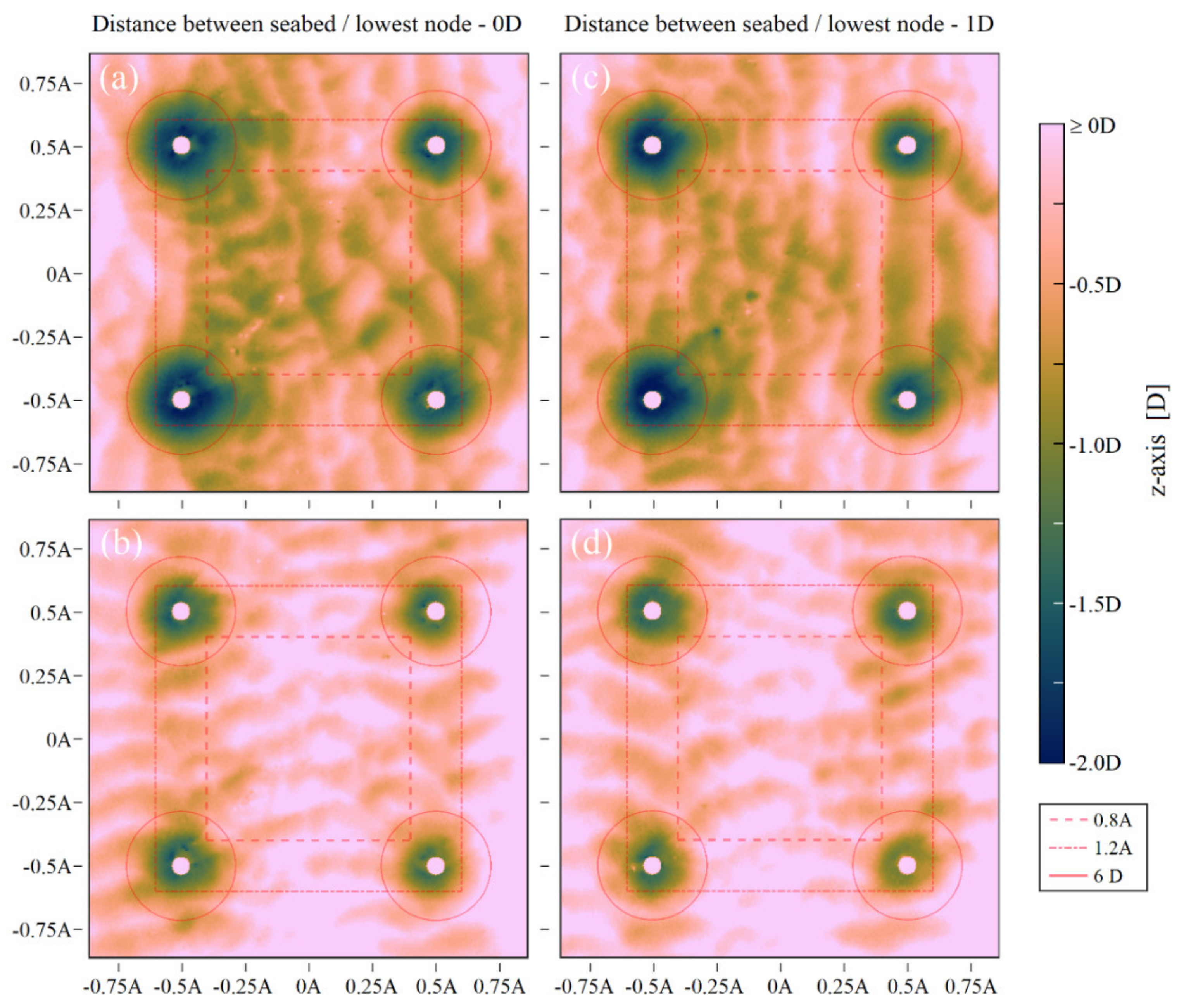
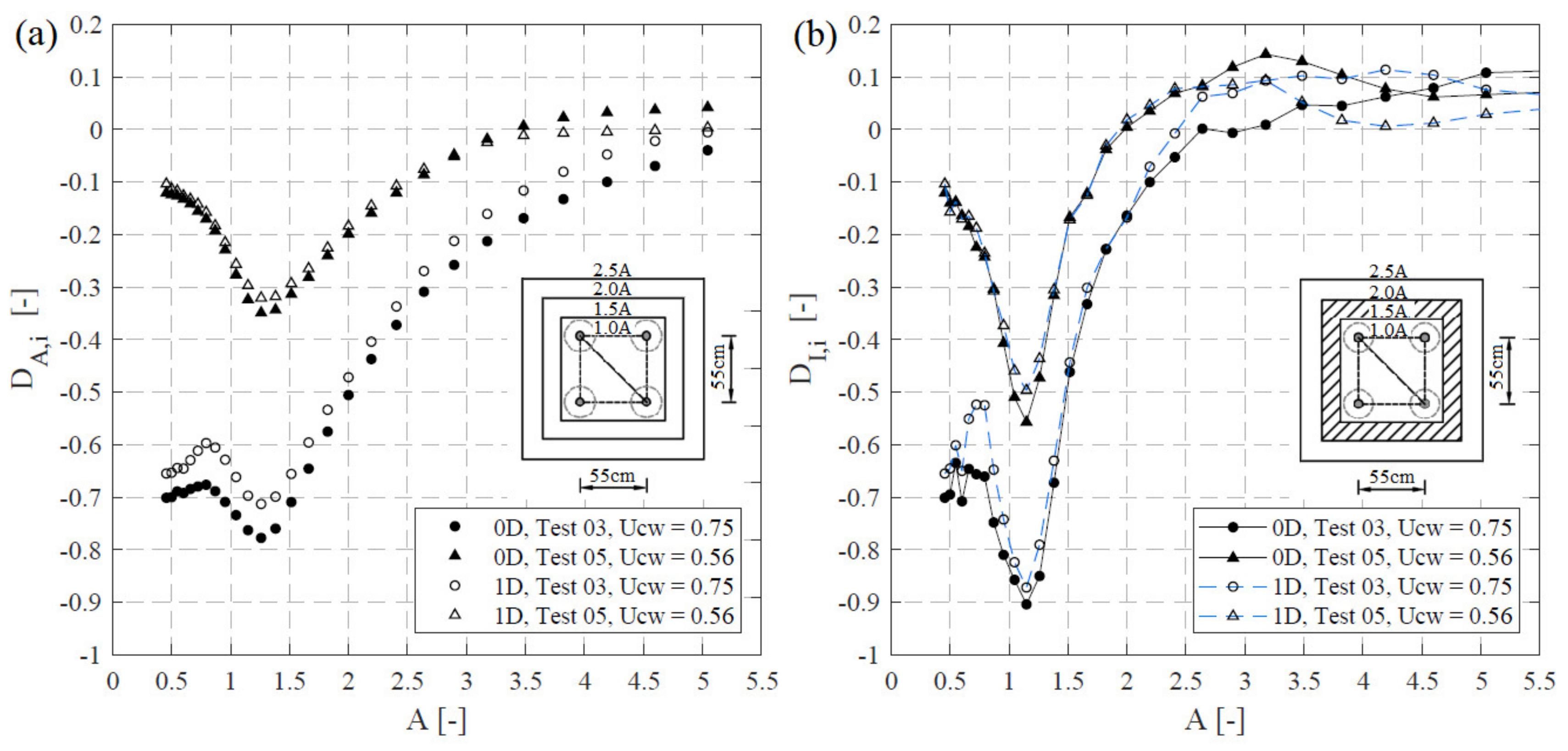
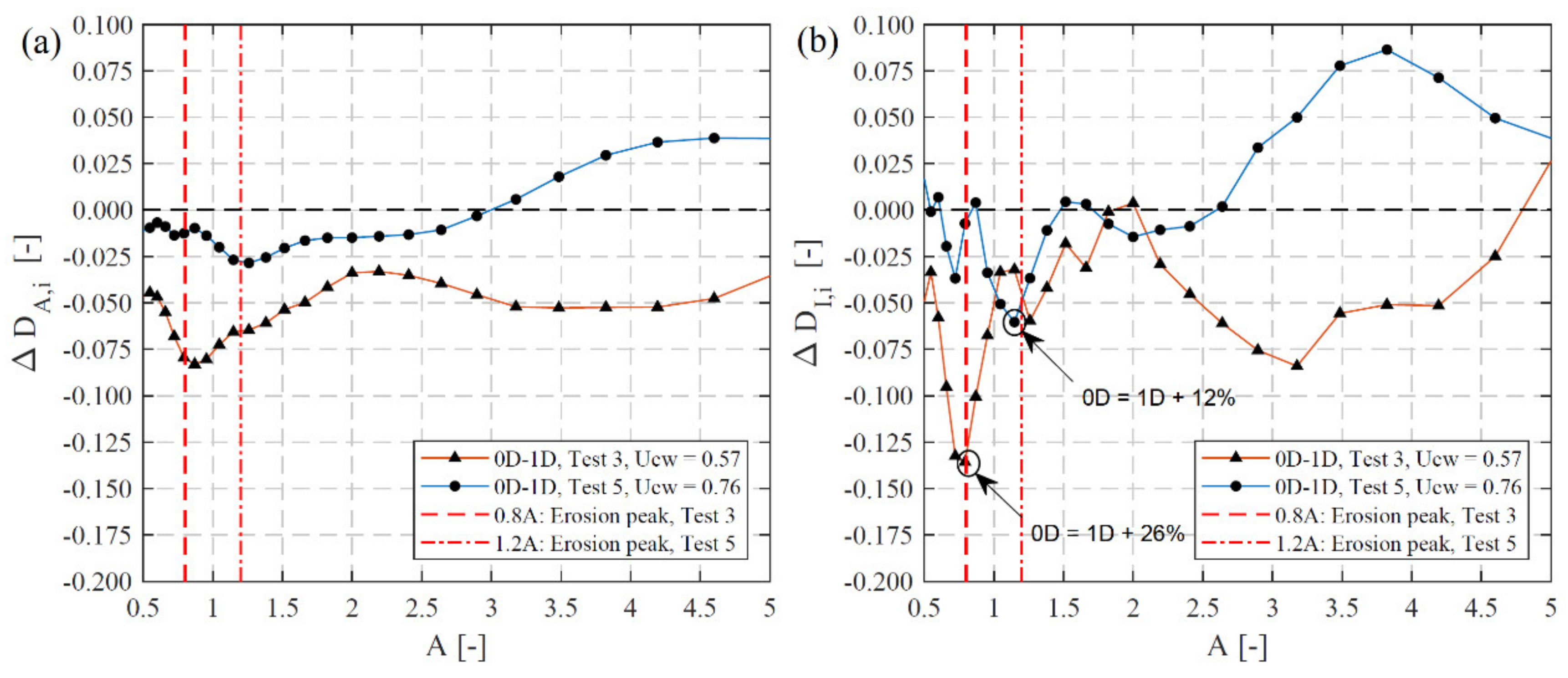
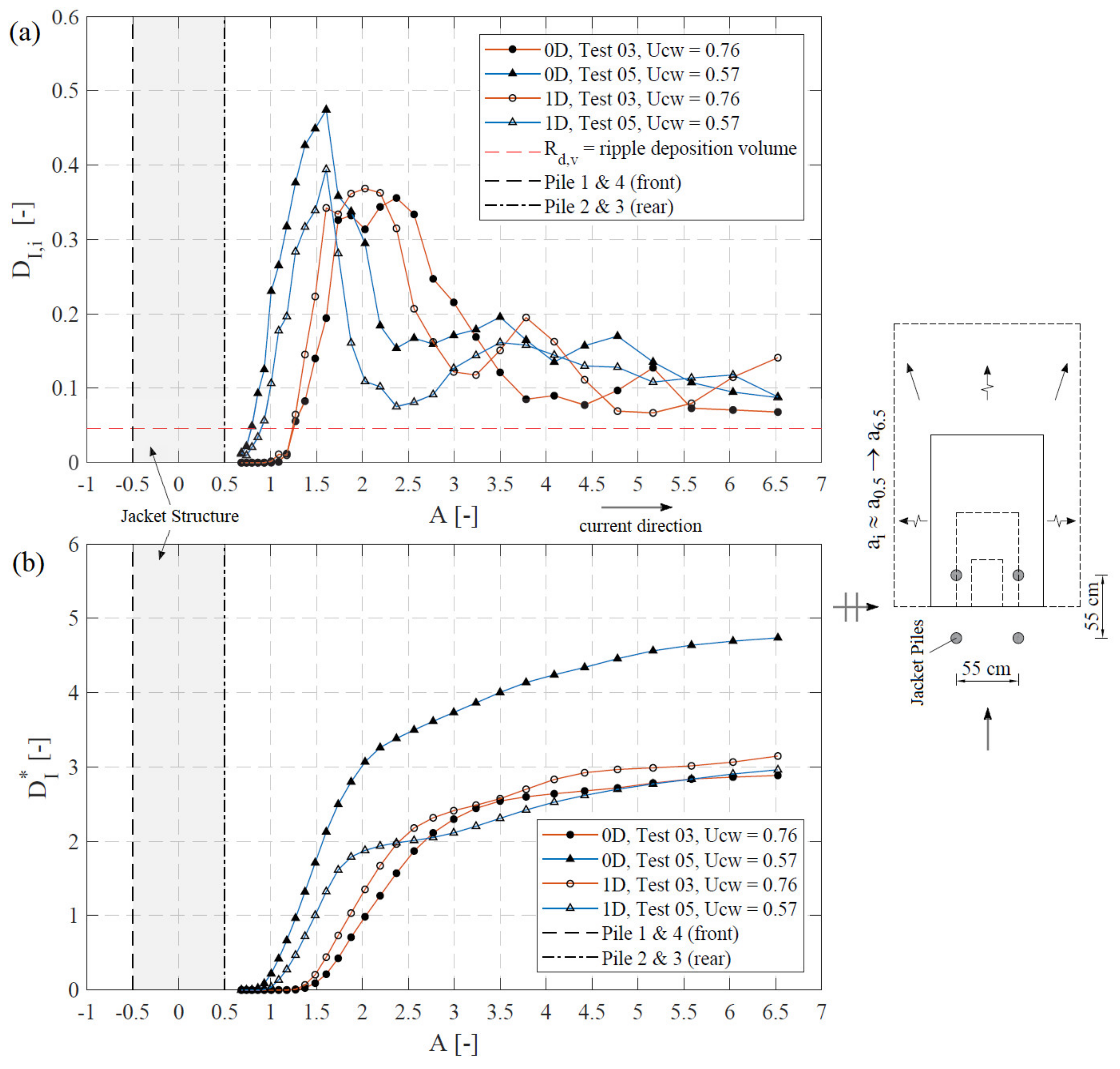
| Test | Node Distance D (m) | Hs (m) | Tp (s) | Um (cm/s) | U (cm/s) | Uc (cm/s) | KC (-) | Ucw (-) | Shields Parameter θ (-) | Pile 1 Send/D (-) | Pile 3 Send/D (-) |
|---|---|---|---|---|---|---|---|---|---|---|---|
| 1 | 0D | 0.147 | 2.0 | 13.3 | 11.4 | 10.1 | 6.7 | 0.43 | 0.067 | 0.403 | 0.238 |
| 2 | 0D | 0.147 | 2.0 | 13.3 | 24.3 | 22.5 | 6.7 | 0.63 | 0.078 | 0.801 | 0.786 |
| 3 | 0D | 0.147 | 2.0 | 13.3 | 41.7 | 38.8 | 6.7 | 0.75 | 0.123 | 1.571 | 1.268 |
| 4 | 0D | 0.158 | 3.4 | 17.5 | 11.4 | 10.1 | 14.9 | 0.37 | 0.076 | 0.884 | 0.580 |
| 5 | 0D | 0.158 | 3.4 | 17.5 | 24.3 | 22.5 | 14.9 | 0.56 | 0.087 | 1.317 | 1.075 |
| 1 * | 1D | 0.147 | 2.0 | 13.3 | 11.4 | 10.1 | 6.7 | 0.43 | 0.067 | 0.464 | 0.271 |
| 2 * | 1D | 0.147 | 2.0 | 13.3 | 24.3 | 22.5 | 6.7 | 0.63 | 0.078 | 0.863 | 0.708 |
| 3 ** | 1D | 0.147 | 2.0 | 13.3 | 41.7 | 38.8 | 6.7 | 0.75 | 0.123 | 1.502 | 1.133 |
| 4 * | 1D | 0.158 | 3.4 | 17.5 | 11.4 | 10.1 | 14.9 | 0.37 | 0.076 | 0.735 | 0.622 |
| 5 ** | 1D | 0.158 | 3.4 | 17.5 | 24.3 | 22.5 | 14.9 | 0.56 | 0.087 | 1.205 | 1.038 |
© 2020 by the authors. Licensee MDPI, Basel, Switzerland. This article is an open access article distributed under the terms and conditions of the Creative Commons Attribution (CC BY) license (http://creativecommons.org/licenses/by/4.0/).
Share and Cite
Welzel, M.; Schendel, A.; Goseberg, N.; Hildebrandt, A.; Schlurmann, T. Influence of Structural Elements on the Spatial Sediment Displacement around a Jacket-Type Offshore Foundation. Water 2020, 12, 1651. https://doi.org/10.3390/w12061651
Welzel M, Schendel A, Goseberg N, Hildebrandt A, Schlurmann T. Influence of Structural Elements on the Spatial Sediment Displacement around a Jacket-Type Offshore Foundation. Water. 2020; 12(6):1651. https://doi.org/10.3390/w12061651
Chicago/Turabian StyleWelzel, Mario, Alexander Schendel, Nils Goseberg, Arndt Hildebrandt, and Torsten Schlurmann. 2020. "Influence of Structural Elements on the Spatial Sediment Displacement around a Jacket-Type Offshore Foundation" Water 12, no. 6: 1651. https://doi.org/10.3390/w12061651
APA StyleWelzel, M., Schendel, A., Goseberg, N., Hildebrandt, A., & Schlurmann, T. (2020). Influence of Structural Elements on the Spatial Sediment Displacement around a Jacket-Type Offshore Foundation. Water, 12(6), 1651. https://doi.org/10.3390/w12061651







